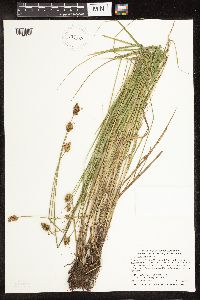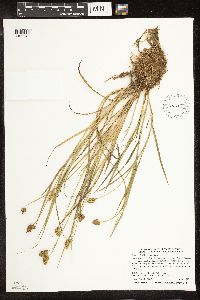Carex bebbii
|
|
|
|
Family: Cyperaceae
Bebb's Sedge, more...Bebb sedge
[Carex tribuloides var. bebbii] |
Plants densely cespitose. Culms 20-90 cm; vegetative culms inconspicuous with few leaves clustered at apex. Leaves: sheaths white-hyaline or green-veined, sometimes papillose, summits U-shaped, not distally expanded; distal ligules 2.2-6 mm; blades 3-4 per fertile culm, 11-25 cm × 1.7-4.2 mm. Inflorescences mostly dense, brown, 1.1-3 cm × 5-14 mm; proximal internode 1-4 mm; 2d internode 1.4-3.4 mm; proximal bracts scalelike, with bristle tips shorter than inflorescences. Spikes 3-10, usually overlapping, ovoid to globose, 4-10 × 3-7 mm, base rounded or truncate, apex rounded. Pistillate scales reddish brown, usually with green or whitish to brown midstripe, lanceolate, 2.5-3.5 mm, shorter and narrower than perigynia, apex acuminate or acute. Perigynia ascending to ascending-spreading, light to dark reddish brown, conspicuously 3+-veined abaxially, faintly or basally 1-3-veined adaxially, winged to base, ovate or elliptic, plano-convex, 2.5-3.8 × (1-)1.2-2 mm, 0.35-0.45 mm thick, 1.9-2.5 times as long as wide, margin flat, including wing 0.2-0.5 mm wide, 1b ciliate-serrulate at least distally; beak reddish brown at tip, flat, ± ciliate-serrulate, abaxial suture with reddish brown-hyaline margin, distance from beak tip to achene 1.2-2.2 mm. Achenes ovate or elliptic, 1-1.3 × 0.6-0.9 mm, 0.3-0.4 mm thick. 2n = 68, 70. Fruiting early summer. Wet places with calcareous or neutral soils, gravelly lakeshores, stream banks, meadows, forest seeps; 0-2100 m; Alta., B.C., Man., N.B., Nfld. and Labr., N.W.T., N.S., Ont., P.E.I., Que., Sask.; Alaska, Colo., Conn., Idaho, Ill., Ind., Iowa, Maine, Mass., Mich., Minn., Mont., Nebr., N.H., N.J., N.Y., N.Dak., Ohio, Oreg., Pa., S.Dak., Utah, Vt., Wash., Wis., Wyo. In addition to typical perennial behavior, Carex bebbii may reach reproductive stage from seed in a single season, thus behaving as a facultative annual. Carex athrostachya and C. crawfordii may share this reproductive feature.
Densely tufted, 2-9 dm, aphyllopodic; lvs elongate, mostly 2-4 mm wide; sheaths ventrally hyaline; spikes 4-12, gynaecandrous, 5-9 mm, pale greenish to stramineous or light brown, sessile in a compact, crowded spike or head 1.5-3 cm; bracts inconspicuous, even the lowest one shorter than the infl, pistillate scales shorter and narrower than the perigynia, largely hyaline-scarious except for the firmer, often greenish midrib; perigynia crowded, stiffly ascending (the beaks often standing out from the body of the spike), ovate, 2.7-3.7 נ1.1-1.5 mm, 2-2.7(-3) times as long as wide, planoconvex, evidently nerved on both sides or nerveless ventrally, wing-margined and serrulate, tapering to an ill-defined, flattened, serrulate beak; achene lenticular, 1.1-1.5 נ0.6-0.8 mm; 2n=68. Wet meadows and shores, especially in calcareous soil; Nf. to B.C., s. to N.J., Ill., Nebr., and Colo. Gleason, Henry A. & Cronquist, Arthur J. 1991. Manual of vascular plants of northeastern United States and adjacent Canada. lxxv + 910 pp. ©The New York Botanical Garden. All rights reserved. Used by permission. From Flora of Indiana (1940) by Charles C. Deam Infrequent in marshes and interdunal swales in Lake County. In Noble County a single collection was made by Deam in a ditch along a railroad a mile east of Kimmel. Plants of Carex bebbii lacking sterile culms are occasionally difficult to distinguish from C. cristatella especially before the perigynia are fully mature. Leaf blades of C. bebbii, however, vary from 2 to 4.5 mm broad, those of C. cristatella from 3 to 7 mm broad. In C. bebbii the pistillate scales are relatively longer, acuminate to acute or occasionally blunt; in C. cristatella the scales are shorter, with dilated hyaline blunt tips. Umbach no. 3651 and Bebb nos. 541 and 874, all from Lake County, are intermediate between C. bebbii and C. cristatella in most of their characters. Similar material from Michigan has been identified by Mackenzie as a hybrid between the two species. ...... Indiana Coefficient of Conservatism: C = 7 Wetland Indicator Status: OBL |































































































